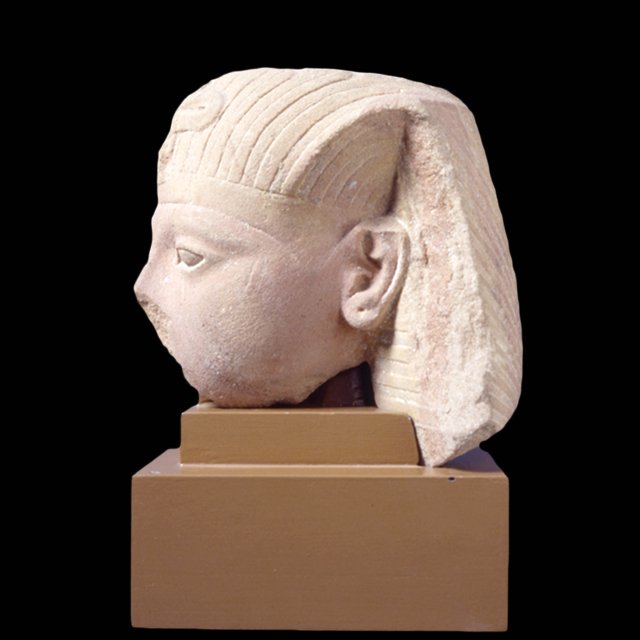New Kingdom Rulers
- Neolithic Period: 4500-3000 BCE
- Early Dynastic: 3000-2650 BCE
- Old Kingdom: 2650-2150 BCE
- 1st Intermediate Period: 2150-2040 BCE
- Middle Kingdom: 2040-1640 BCE
- 2nd Intermediate Period: 1640-1550 BCE
- New Kingdom: 1550-1070 BCE
- - Architects: Amenhotep, Son of Hapu
- - Architects: Senenmut
- - Rulers: Amenhotep III
- - Rulers: Amenhotep IV
- - Rulers: Hatshepsut
- - Rulers: Ramses II
- - Rulers: Ramses III
- - Rulers: Thutmose III
- - Rulers: Tutankhamun
- - Monuments: Abu-Simbel
- - Monuments: Abydos - The Temple of Seti
- - Monuments: Akhetaton (Tell el-Amarna)
- - Monuments: Amenhotep III’s Mortuary Complex
- - Monuments: Deir-el-Bahri
- - Monuments: Luxor Temple
- - Artifacts: Link to Collection Search
- 3rd Intermediate Period: 1070-712 BCE
- Saite and Late Periods: 712-332 BCE
- Greco-Roman Period: 332 BCE-642 CE
- Coptic Period: 395-642 CE
- Islamic Period and Modern Times: 642 CE-Today
- Neolithic Period: 4500-3000 BCE
- Early Dynastic: 3000-2650 BCE
- Old Kingdom: 2650-2150 BCE
- 1st Intermediate Period: 2150-2040 BCE
- Middle Kingdom: 2040-1640 BCE
- 2nd Intermediate Period: 1640-1550 BCE
- New Kingdom: 1550-1070 BCE
- - Architects: Amenhotep, Son of Hapu
- - Architects: Senenmut
- - Rulers: Amenhotep III
- - Rulers: Amenhotep IV
- - Rulers: Hatshepsut
- - Rulers: Ramses II
- - Rulers: Ramses III
- - Rulers: Thutmose III
- - Rulers: Tutankhamun
- - Monuments: Abu-Simbel
- - Monuments: Abydos - The Temple of Seti
- - Monuments: Akhetaton (Tell el-Amarna)
- - Monuments: Amenhotep III’s Mortuary Complex
- - Monuments: Deir-el-Bahri
- - Monuments: Luxor Temple
- - Artifacts: Link to Collection Search
- 3rd Intermediate Period: 1070-712 BCE
- Saite and Late Periods: 712-332 BCE
- Greco-Roman Period: 332 BCE-642 CE
- Coptic Period: 395-642 CE
- Islamic Period and Modern Times: 642 CE-Today
Tutankhamun
1344 – 1327 BCE
Tutankhamun (commonly referred to as “King Tut” today) was born Tutankhaton, which means “the living image of Aton.” He was the son of Akhnaton, the pharaoh who changed Egypt from a polytheistic to a monotheistic society during his reign. During Tutankhamun’s reign, Egypt’s state religion was restored to the worship of many different deities.
Soon after Akhnaton’s death, Tutankhamun was crowned at Memphis, the traditional secular capital. To symbolize the change in Egypt’s religion from worshipping the Aton to worshipping many deities, Tut replaced the ending of his name, “Aton,” with “Amun” and became known as Tutankhamun. He was nine years old when he became pharaoh and married his sister Ankhesenamun, who replaced the Aton in her name with Amun.
Apart from the transition away from monotheism, there is not a lot of documentation about King Tut’s rule. He is not listed among the classic kings in the Egyptian records like his relatives. Tutankhamun only ruled for nine years and died when he was about seventeen years old. The cause of his death is not known, although there are many theories ranging from malaria to a chariot accident, however assassination has largely been ruled out.
The difference in size of King Tut’s tomb compared to the other pharaohs’ tombs in the Valley of the Kings leads to the conclusion that he was not buried in his intended tomb, probably because he died suddenly and so young. The mummification process took seventy days and after that time period, the mummy must be buried. The tomb Tutankhamun was found in was likely intended for someone else. Some of the world’s leading archaeologists are researching this today.
King Tut’s tomb, discovered in 1922 by British archaeologist and Egyptologist, Howard Carter, was filled with treasures, including his solid gold face mask, a solid gold sarcophagus, a large wooden figure of the god of mummification, Anubis, all four of his canopic jars, two other sarcophagi made of wood and plated with gold, and the mummified remains of two of Tutankhamun’s stillborn daughters.

Image: RC 358 Tutankhamun Statue Fragment at the Rosicrucian Egyptian Museum.
3D Model - Tutankhamun Statue Fragment on Sketchfab
Clayton, Peter A., Chronicle of the Pharaohs: The Reign-by-Reign Record of the Rulers and Dynasties of Ancient Egypt. Thames & Hudson, New York, 2006.
http://www.history.com/topics/ancient-history/tutankhamen
http://news.nationalgeographic.com/2015/11/151124-tut-biography-egypt-tomb-archaeology/
Reeves, Nicholas. Complete Tutankhamun: The King, the Tomb, the Royal Treasure. Thames & Hudson, New York, 1990.

